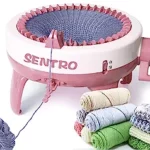Picture this: You're sitting on the couch, all cozied up with your knitting needles and a ball of yarn, determined to conquer the elusive "ssk" stitch. As you read the pattern, it might as well be written in a secret code decipherable only by ancient knitting gurus.
You take a deep breath, hoping for divine inspiration, and attempt to execute the ssk. But instead of gracefully slipping, slipping, and then knitting the stitches together, your needles seem to have a mind of their own. It's like trying to wrangle a pair of mischievous squirrels hopped up on caffeine.
The yarn twists around your fingers, the needles tangle themselves in a chaotic dance, and you end up with a jumbled mess that resembles a cat's attempt at knitting. "What even is an ssk? Slip, slip... chaos?" you mutter to yourself in frustration.
In a last-ditch effort, you turn to YouTube for guidance. But the confident knitter in the video performs the ssk with such ease and grace that it's almost infuriating. It's like watching a professional figure skater execute a flawless triple axel while you struggle to stay upright on ice.
Determined not to be defeated by a mere knitting stitch, you try again. Slip, slip, fumble, curse, and repeat. You lose count of how many times you unravel your work, leaving a trail of failed ssk attempts in your wake.
But just when you're about to throw in the towel, something magical happens. Your fingers suddenly find their rhythm, and the yarn cooperates like a well-trained circus performer. You slip those stitches, and with a flick of the wrist, you gracefully knit them together.
Victory! You've finally conquered the ssk stitch! You celebrate like you've won a gold medal at the Knitting Olympics, proudly displaying your beautifully executed ssk to anyone who will listen.
In the end, mastering the ssk in knitting is like a comedic journey filled with trials, errors, and a touch of desperation. But as you proudly gaze upon your finished project, you realize that the struggle was worth it. So, next time you encounter a tricky knitting stitch, remember that with a bit of perseverance and a sprinkle of humor, you can conquer any knitting challenge that comes your way. Happy knitting!
Introduction
Knitting is a wonderful craft that offers endless possibilities for creating beautiful textures and patterns. One of the essential techniques in knitting is the SSK (Slip, Slip, Knit) decrease, commonly used to shape and contour your knitting projects. Despite its initial complexity, mastering the SSK can significantly enhance the appearance of your finished pieces. In this comprehensive guide, we will break down the SSK step-by-step, providing you with the knowledge and confidence to execute this decrease flawlessly.
Understanding the SSK Decrease
The SSK decrease is a left-leaning decrease that slants your stitches to the left side, creating a smooth and polished look. It is often used in lace patterns, raglan sleeves, and any design where a neat decrease is required. The SSK is the mirror image of the K2tog (Knit Two Together) decrease, which slants stitches to the right.
Preparing to SSK
Before starting the SSK, ensure that you have a working knowledge of the basic knit stitch and are comfortable working with two needles. Familiarize yourself with the knitting abbreviations commonly used in patterns, as SSK is one of the standard abbreviations you'll frequently encounter.
SSK Step-by-Step Guide
Step 1: Slip the First Stitch
To begin the SSK decrease, insert your right needle into the first stitch on the left needle as if you were going to knit it. However, instead of knitting the stitch, simply slip it from the left needle to the right needle without knitting it.
Step 2: Slip the Second Stitch
Similarly, insert your right needle into the second stitch on the left needle as if you were going to knit it, but slip this stitch to the right needle as well, without knitting it.
Step 3: Knit the Two Slipped Stitches Together
Once you have slipped both stitches onto the right needle, insert the left needle through the front loops of the two slipped stitches, from left to right. Now, knit these two stitches together as if they were one stitch. This forms the SSK decrease.
Tips for a Neat SSK Decrease
- Maintain a consistent tension throughout the SSK to ensure even stitches.
- To avoid twisting the slipped stitches, ensure that they remain in the same orientation on the right needle as they were on the left.
- If the SSK feels too tight, consider using a larger needle or adjusting your tension.
- Practice on a swatch before attempting the SSK in your actual project to build confidence and familiarize yourself with the technique.
Common Mistakes to Avoid
- Confusing SSK with K2tog: Remember that the SSK slants stitches to the left, while the K2tog slants them to the right. Pay attention to the pattern instructions to ensure you use the correct decrease for your project.
- Twisting the Slipped Stitches: Be mindful not to twist the slipped stitches when transferring them to the right needle. This can lead to a messy and uneven decrease.
- Overly Tight SSK: If your SSK is too tight, it can cause your knitting to pucker. Practice keeping an even tension and adjusting your technique as needed.
Conclusion
Mastering the SSK decrease in knitting opens up a world of possibilities for creating beautiful and professional-looking projects. Once you become comfortable with this technique, you'll find yourself incorporating it into various patterns, adding a touch of elegance and sophistication to your knitting. Like any skill in knitting, the key is practice and patience. Embrace the learning process and don't be discouraged by initial challenges. With time and dedication, you'll be executing the SSK decrease with confidence and finesse. Happy knitting!
To find out more about knitting, please visit any of the following areas:
- How to sew together knitting
- What is brioche knitting
- How to join yarn in knitting
- How to join in the round knitting
- How to finish a knitting scarf
- How to make a slip knot for knitting
- How to switch colors knitting
- How to hold yarn when knitting
- What does kfb mean in knitting
- How to fix a dropped stitch in knitting
- How to hold knitting needles
- What is frogging in knitting?
- How to change colors in knitting
- How to count rows in knitting
- How to increase in knitting
- How to slip stitch knitting
- How to yarn over in knitting
- What is a knitting loom?
- How to make bobbles in knitting?
- Where can I buy sentro knitting machine?
- What can you make with a sentro knitting machine?
- Cricut Hat Press: A Comprehensive Guide on Usage - August 13, 2023
- Unlocking Creativity with the Cricut Joy: A Comprehensive Guide - August 12, 2023
- The Ultimate Guide to the Cricut Maker Bundle - August 11, 2023





